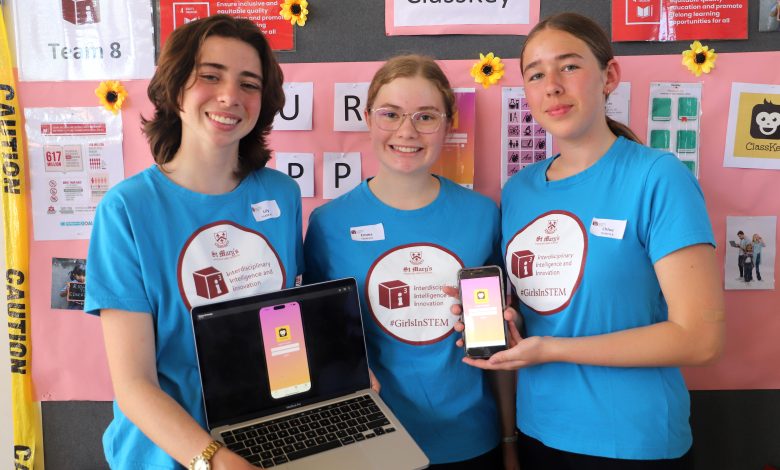
“I went to The Perse School for Girls, Cambridge, UK. I planned to study Civil Engineering at university as I wanted to make a difference in this world, one that would have a lasting effect beyond my lifetime. When I opened the door to my first university lecture, there were more than 100 male faces and just two females sitting at the front of the room looking stunned. I did not step through the door; I walked out and changed my career pathway. I have spent most of my teaching life in girls’ education. I do not want any student to feel the same overwhelming fear that I felt the day I walked into that lecture theatre.” Michelle Fitzpatrick
Michelle Fitzpatrick is the Head of Technology and Enterprise at St Mary’s Anglican Girls School in Perth, an independent K-12 school with over 1,400 students. She is acknowledged as one of Australia’s top educators and innovators, being recognised in both the Educator’s Hot List and as an Apple Distinguished Educator. She spoke with School News about the process of developing an innovative new learning program.
Read the latest issue of School News HERE
“Shortly after I started at St Mary’s in 2013, I realised we needed to offer students a cutting-edge, technology-based subject. I found out about the competition Search for the Next Tech Girl Superhero, which enabled girls to problem-solve and produce a business plan, pitch video and app using MIT App Inventor. After teaching the students some basic app development, we entered the competition,” explains Fitzpatrick. “Teams were allocated an online industry mentor and one team had an inspirational mentor, Sandy Abrahams from Avanade. In our first year, that team went on to win the Secondary National Search for the Next Tech Girl Superhero competition with their app, Vocabulary Voyagers – a free literacy app targeted at helping primary school students to improve their literacy reading skills in a fun, digital environment.”
The impact of having a motivated and inspiring industry mentor proved a key trigger for the development of the i3 program, launched in 2018 and which has now become a compulsory STEM-based subject for all girls in Year 10.
The i3 program
i3 stands for Interdisciplinary, Intelligence and Innovation. The year-long program involves students working in teams alongside industry mentors to solve one of the United Nations’ Sustainable Development Goals. Fitzpatrick explains: “Through a variety of inquiry and project-based activities, following the design thinking process, teams are required to produce a range of deliverables, including a digital solution which they pitch to a panel of judges at a culminating event called the i3 Live Pitch Showcase.”
With a STEM team consisting of Fitzpatrick, Education Technology Integrator David Brown, the Deputy Principal, Head of Science and Head of Maths, the program was developed – and continues to evolve – with the theme of the project being a GPS app which the girls would develop using science investigations and mathematical concepts.
One of the goals of the program is to ensure early exposure to crucial work-ready skills. “I believe it is imperative that we afford opportunities for all students to have the confidence and potential to become our future leaders and changemakers. That is why we made the i3 Program accessible to all students, rather than just our gifted and talented girls,” says Fitzpatrick. Aligning with the school’s strategic plan, the learning outcomes of the i3 program include:
- enabling students to recognise, adapt to and manage change
- providing ‘real-world’ experiences that empower girls to be purposeful and have personal agency
- encouraging students to be active learners and develop strong relationships beyond the walls of the school.

Real World Experience
Key to the success of the program is the fact that connections, learning opportunities and outcomes exist well beyond the school’s boundaries. Industry Mentor, Sandy Abrahams from Avenade, was called in to assist with identifying 10 transferable skills that universities and workplaces saw as lacking in new graduates. Through continued research, that number has now increased to 25.
Another innovative component of the program is the involvement of both Industry and Student Mentors. Fitzgerald explains: “they are an integral component of the i3 Program. Each team of students have two mentors for the year, who regularly communicate with their team to offer expertise, support and encouragement. Industry mentors come from a variety of organisations across the public, private and non-profit sectors, and who volunteer their time throughout the year. Student Mentors are Year 11 St Mary’s Students who participated in the i3 Program the preceding year.”
The program is constantly being evaluated and updated, ensuring it remains cutting-edge. “We undertake continuous scenario planning throughout each term, as part of a debrief and meet with mentors for professional development every term. We build natural feedback mechanisms into the program that allows everyone (students, mentors, teachers) to develop an openness to change.”
Challenges and advice
The process of developing the new program took a number of years and involved teaching staff from across the school, external consultants and research from both universities and industry.
“A lot of time was spent on research and development to ensure we were achieving the specific aims and objectives when writing the curriculum content. When you build your case for creating an engaging program like ours, one of the key points to remember is that everyone involved has to come along on the journey. You need to have passionate and invested people leading the program and you must provide them with the time required to develop, build and maintain the program.”
“A sustainable network is required to make it work, including both behind the scenes and on event days. A priority is maintaining connections with mentors and industry, taking feedback, adapting and problem-solving.” Michelle Fitzpatrick
The fact that the program was problem-based rather than text-based, was also a consideration in making the course accessible for neuro-atypical students and those who had different learning styles. “We were very mindful to ensure all students could engage with the content, which took a lot of time,” says Fitzpatrick. “We factored in how we present information, including tasks, curriculum content and examples so that it is accessible and engaging for all students and mentors. We include a range of text, videos, and infographics to ensure that different styles of learning are accommodated.”
The success of the program over its first five years speaks for itself. “The number of St Mary’s students that have pursued STEM-based university degrees since the i3 Program launched has increased from 43 per cent to between 59 and 68 per cent. One student secured a five-figure contract to create an app and by age 17 she established her own company. Many students have secured work experience opportunities through the program, while others return to mentor current students,” says Fitzpatrick.

“It is hard to stay at the forefront in this educational space, but we are doing everything we can to give our students the best start that they deserve. Building connections, joining in the many conversations, and sustaining relationships and your network is required to make these programs work. A K-12 plan for your students is invaluable and should be a priority for any school not already on this journey, to enable all students these opportunities. “







